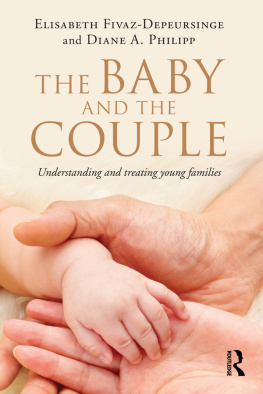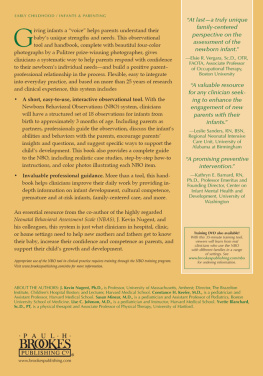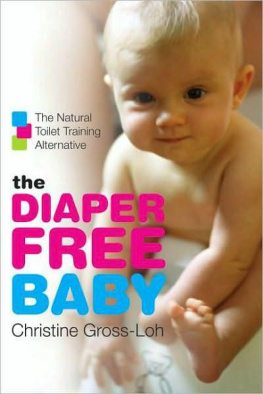The Baby and the Couple
The Baby and the Couple provides an insiders view on how infant communication develops in the context of the family and how parents either work together as a team or struggle in the process. The authors present vignettes from everyday life as well as case studies from a longitudinal research project of infants and their parents interacting together in the Lausanne Trilogue Play (LTP), an assessment tool for very young families.
Divided into three sections, the book focuses not only on the parents but also on the infants contribution to the family. , prevention and intervention models based on the LTP are presented. In addition to an overview of these programs, chapters are devoted to the Developmental Systems Consultation, which combines use of the LTP and video feedback, and a new model, Reflective Family Play, which allows whole families to engage in treatment.
The Baby and the Couple is a vital resource for professionals working in the fields of infant and preschool mental health, including psychiatrists, psychologists, social workers, family therapists, and educators, as well as researchers.
Elisabeth Fivaz-Depeursinge is a former professor of clinical ethology at the University of Lausanne School of Medicine, where she was president of the Centre for Family Studies and head of its research department. She was a practicing child analyst and family therapist before moving into clinical research.
Diane A. Philipp is an assistant professor in the Department of Psychiatry at the University of Toronto Medical School and a member of the faculty at the Hincks-Dellcrest Centre, where she is part of the infant and preschool assessment and treatment team.
First published 2014
by Routledge
27 Church Road, Hove, East Sussex, BN3 2FA
and by Routledge
711 Third Avenue, New York, NY 10017
Routledge is an imprint of the Taylor & Francis Group, an informa business
2014 Elisabeth Fivaz-Depeursinge and Diane A. Philipp
The right of Elisabeth Fivaz-Depeursinge and Diane A. Philipp to be identified as authors of this work has been asserted by them in accordance with sections 77 and 78 of the Copyright, Designs and Patents Act 1988.
All rights reserved. No part of this book may be reprinted or reproduced or utilised in any form or by any electronic, mechanical, or other means, now known or hereafter invented, including photocopying and recording, or in any information storage or retrieval system, without permission in writing from the publishers.
Trademark notice: Product or corporate names may be trademarks or registered trademarks, and are used only for identification and explanation without intent to infringe.
British Library Cataloguing in Publication Data
A catalogue record for this book is available from the British Library
Library of Congress Cataloging-in-Publication Data
Fivaz-Depeursinge, Elisabeth.
The baby and the couple : understanding and treating young families / Elisabeth Fivaz-Depeursinge and Diane Philipp.
pages cm
1. Parent and infant. 2. Infants. 3. Infant psychology.
I. Philipp, Diane. II. Title.
BF720.P37.F58 2014
155.422dc23
2013047752
ISBN: 978-0-415-84495-6 (hbk)
ISBN: 978-0-415-84496-3 (pbk)
ISBN: 978-1-315-77977-5 (ebk)
Typeset in Times New Roman
by Apex CoVantage, LLC
Contents
by James P. McHale
WITH CHLO LAVANCHY SCAIOLA
WITH SARAH CAIRO
WITH FRANCESCO LOPES
WITH NICOLAS FAVEZ
WITH ANTOINETTE CORBOZ-WARNERY
WITH MIRI KEREN
WITH FRANCE FRASCAROLO-MOUTINOT
WITH JOLLE DARWICHE
11 An in-depth look at the LTP and video-feedback
WITH ANTOINETTE CORBOZ-WARNERY
WITH CHRISTIE HAYOS AND HERV TISSOT
Sarah Cairo, Department of Psychology, Faculty of Psychology and Educational Sciences, University of Geneva
Antoinette Corboz-Warnery, Research Unit of the Centre for Family Studies (UR-CEF), University Institute of Psychotherapy (IUP), DP-CHUV, Lausanne University, Switzerland
Jolle Darwiche, Institute of Psychology, Faculty of Social and Political Sciences, University of Lausanne, Switzerland
Nicolas Favez, Department of Psychology, Faculty of Psychology and Educational Sciences, University of Geneva and Research Unit of the Centre for Family Studies (UR-CEF), University Institute of Psychotherapy (IUP), DPCHUV, Lausanne University, Switzerland
Elisabeth Fivaz-Depeursinge, Research Unit of the Centre for Family Studies (UR-CEF), University Institute of Psychotherapy (IUP), DP-CHUV, Lausanne University, Switzerland
France Frascarolo-Moutinot, Research Unit of the Centre for Family Studies (UR-CEF), University Institute of Psychotherapy (IUP), DP-CHUV, Lausanne University, Switzerland
Christie Hayos, Hincks-Dellcrest Centre & University of Toronto, Canada
Miri Keren, Geha Mental Health Center, Tel-Aviv University, Israel
Chlo Lavanchy Scaiola, Research Unit of the Centre for Family Studies (URCEF), University Institute of Psychotherapy (IUP), DP-CHUV, Lausanne University, Switzerland
Francesco Lopes, Research Unit of the Centre for Family Studies (UR-CEF), University Institute of Psychotherapy (IUP), DP-CHUV, Lausanne University, Switzerland
Diane A. Philipp, Hincks-Dellcrest Centre & University of Toronto, Canada
Herv Tissot, Department of Psychology, Faculty of Psychology and Educational Sciences, University of Geneva and Research Unit of the Centre for Family Studies (UR-CEF), University Institute of Psychotherapy (IUP), DP-CHUV, Lausanne University, Switzerland
Understanding triadic and family-level dynamics is not work that comes effortlessly. Yet somehow, almost magically, Fivaz-Depeursinge and Philipp make the work seem effortless and bring the process of understanding and helping families into the clear light of day in this compelling book. Laying a foundation in the careful science of reading and interpreting the affective and behavioral signals of triadic interactions, Fivaz-Depeursinge and Philipp first guide the reader through their process of understanding the normal development of three-way intersubjective and multiperson communication in infants. With this foundation of what cooperative coparenting and family alliances can look like, they move on to illustrate families that struggle with exclusion, misattunement, competitiveness, triangulation, and difficulty sustaining a shared focus. Family patterns and dynamics come to life in the stories of Lucas, Gabriella, Miles, Myriam, and the other children featured in this book, and make the kinds of interventions Fivaz-Depeursinge and Philipp bring into the consulting room seem intuitively obvious.
One of the more creative elements of Fivaz-Depeursinge and colleagues work has always been the attention given to the infants contribution to the family dynamic and to coparenting, from the outset. In structural family theory, there is an emphasis on hierarchy the clear delineation of lines of authority, with the coparents in the family collaborating effectively as the architects and heads of the family system. The capacity of adults to work as a team is what initially captivated me in my own work on coparenting, and many of the ideas and tenets that followed from this focus privilege the adults propensities during family interactions. The parallel attention given to the infant or child, and how he or she affects the family process both in the moment, and later, as an integral player in a crystallized family pattern, adds a missing and in some ways indispensable layer of meaning to the process of interpreting the familys story. This book provides many vivid examples of child contributions and the role they play in contributing to and maintaining the choreography of the familys dance.






